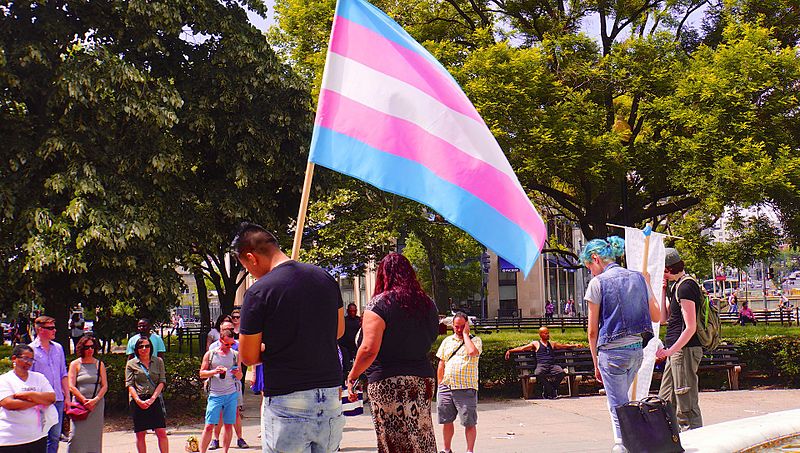|
2/15/2020 0 Comments Decade in Review - The Gender Revolution: A Look Back on the Trans* Movement of the 2010sCatherine Sullivan (she/her) Although the history of trans and gender-nonconforming movements in the United States extends as far back as at least the late 1800s, the past decade has been one of the most notable, marked by presence in culture and politics. Though recent political events have shown some regress, the time we’re living in is one of deep cultural transformations.  Stronger together: Trans and gay rights advocates stand side by side at a GSA march. Photo courtesy of Unsplash. Stronger together: Trans and gay rights advocates stand side by side at a GSA march. Photo courtesy of Unsplash. The Good Throughout the 2010s, stories about trans lives have gained attention in popular media. Television shows like "Orange Is The New Black" at the beginning of the decade and "Euphoria" at the end have brought trans stories to a wider audience. The success of documentaries about trans people like Chaz Bono in "Becoming Chaz" and Jazz Jennings in "I Am Jazz" have demonstrated the public fascination with trans people as we have increasingly been recognized as a prominent part of humanity. Several celebrities came out as transgender, notably Caitlyn Jenner and Lana and Lilly Wachowski. The feminist and leftist Youtube communities have grown to support and often include trans people in an easily accessible source of transgender theory. The change in popular media has run alongside changes in how people and institutions handle trans people. One key victory was the demedicalization of transgender identity. The 2013 edition of the Diagnostic and Statistical Manual of Mental Disorders (DSM-5) moved away from classifying transgender identity as a mental illness (gender identity disorder) and towards treating trans people as correct in their identity but continued to categorize gender dysphoria as a disorder. While there has been some debate over whether gender dysphoria should still be considered a mental disorder, this demonstrates that recent medical research has overwhelmingly supported validating trans identities. Many psychiatric and medical organizations such as the World Health Organization followed suit throughout the decade. Additionally, gender-specific institutions like the Boy Scouts of America and women-only colleges have moved to accept people in terms of how they identify rather than how they were born. Twenty states have added a legally recognized third gender marker to their documents and identification, demonstrating the immense strides in recognition nonbinary people have made over the decade. Activist groups like the Women’s March and Black Lives Matter have made explicit statements about ensuring their movements are intersectional and actively work to include trans people. In the 2018 election cycle, transgender candidates Gerri Cannon (D-NH), Lisa Bunker (D-NH), and Brianna Titone (D-CO) became their states’ first openly transgender state legislators. Between the changes to cultural, institutional, and social acceptance of the trans community in recent years, it’s clear that this isn’t a passing trend. What’s been accomplished in the past decade has had real and likely staying power. The Bad As the 2014 Time article “The Transgender Tipping Point” described, the increased strength and visibility of the transgender movement has led to a turning point. Unfortunately, since the article, much of the change made has not turned our way. Our increased visibility has led to an overwhelming presence of reactionary politics. Conservative media personalities such as Ben Shapiro, Jordan Peterson, and the right-wing Youtube community have introduced a number of reductive arguments against transgender theory into the public consciousness. Many feminist groups have claimed the names Trans-Exclusionary Radical Feminism (TERF) or gender-critical to organize against what they consider the appropriation of their movement. Just as an increasingly large group of people believe trans people are the gender they say they are, an increasingly large group believes trans people are mentally ill or the product of liberalism run amok. This came to a head in 2016 with the political drama surrounding the election of President Trump, including the rise of the neo-Nazi group known as the Alt-Right and, according to the FBI, a drastic increase in hate crimes. Since Trump took office, there have been numerous defeats of transgender legal rights. Several states have adopted “bathroom bills” — laws that either mandate or allow bathroom use to be determined by birth sex rather than by gender identity. Ads supporting these bills have played upon the fear of hostile men preying upon young girls in bathrooms. In 2017, President Trump tweeted that trans people would be barred from military service in any capacity, and after a two-year legal battle up to the Supreme Court, the decision was legitimized. Former Attorney General Jeff Sessions released a memo that employment protections would no longer be extended to trans people. While the Equal Employment Opportunity Commission still stands by these protections, their legal basis is largely at risk. Upcoming Supreme Court decisions will determine the legal status of trans discrimination for the next generation. Moving Forward As former vice president Joe Biden said, the issue of trans rights is “the civil rights issue of our time.” With our newfound public prominence, the cultural, political, and legal battles we take on in the next few years will have far-reaching effects in determining where our movement goes. Historically, as the LGBTQ+ community has reached new levels of influence, the most privileged sub-groups have often evicted the sub-groups that are harder to defend. This has happened between gay and trans people, gender-conforming and non-conforming lesbians, and trans people who can and cannot afford medical transition, to name a few. Now that we are entering into our first era of direct national influence, it is critical that we break the cycle and stand by all trans and gender-nonconforming people as we continue to make progress.
0 Comments
Leave a Reply. |
Search by typing & pressing enter

